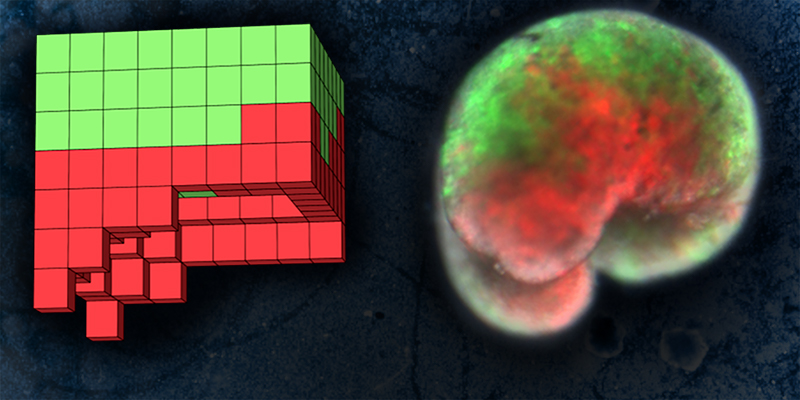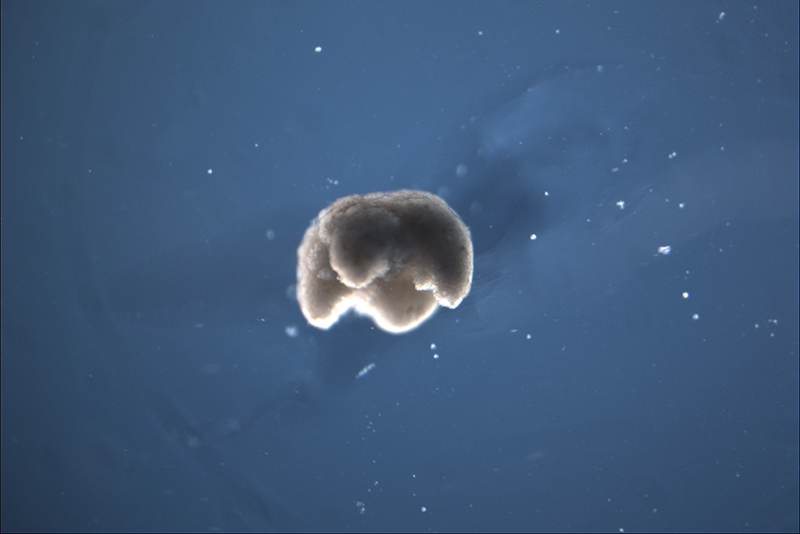
14th January 2020 World's first "living robots" Scientists have repurposed living cells scraped from frog embryos and assembled them into entirely new life-forms. These tiny "xenobots" can move around and even heal themselves if damaged.
A team of scientists has repurposed living cells – scraped from frog embryos – and assembled them into entirely new life-forms. These millimetre-wide "xenobots" can move toward a target, perhaps pick up a payload (such as a medicine that needs to be carried to a specific place inside a patient) and even heal themselves after being cut. "These are novel living machines," says Joshua Bongard, a computer scientist and robotics expert at the University of Vermont (UVM) who co-led the research. "They're neither a traditional robot, nor a known species of animal. It's a new class of artefact: a living, programmable organism." The xenobots were designed on a supercomputer at UVM and then assembled and tested by biologists at Tufts University, Massachusetts. "We can imagine many useful applications of these living robots that other machines can't do," says co-leader Michael Levin, at Tufts' Center for Regenerative and Developmental Biology – "like searching out nasty compounds or radioactive contamination, gathering microplastic in the oceans, or travelling in arteries to scrape out plaque."
People have been manipulating organisms for human benefit since at least the dawn of agriculture. In the modern world, genetic editing has become widespread, and a few artificial organisms have been manually assembled in the past few years – copying the body forms of known animals. But this new research, for the first time ever, "designs completely biological machines from the ground up," the team writes in their new study. With months of processing time on the Deep Green supercomputer cluster at UVM's Vermont Advanced Computing Core, the team used an "evolutionary algorithm" to create thousands of candidate designs for the new life-forms. To achieve a task assigned by the scientists – such as locomotion in one direction – the computer would, over and over, reassemble a few hundred simulated cells into myriad forms and body shapes. As the programs ran, driven by basic rules about the biophysics of what single frog skin and cardiac cells can do, the more successful simulated organisms were kept and refined, while failed designs were tossed out. After a hundred independent runs of the algorithm, the most promising designs were selected for testing. Then the team over at Tufts transferred the in-silico designs into life. First, they gathered stem cells, harvested from embryos of African frogs. These were separated into single cells and left to incubate. Then, using tiny forceps and an even tinier electrode, the cells were cut and joined under a microscope into a close approximation of the designs specified by the computer. Assembled into body forms never seen in nature, the cells began to work together. The skin cells formed a more passive architecture, while the once-random contractions of heart muscle cells were put to work creating ordered forward motion, as guided by the computer's design, and aided by spontaneous self-organising patterns allowing the robots to move on their own. These reconfigurable organisms were shown to be able move in a coherent fashion – and explore their watery environment for days or weeks, powered by embryonic energy stores. Later tests showed that groups of xenobots would move around in circles, pushing pellets into a central location – spontaneously and collectively. Others were built with a hole through the centre to reduce drag. In simulated versions of these, the scientists were able to repurpose this hole as a pouch to successfully carry an object.
"It's a step toward using computer-designed organisms for intelligent drug delivery," adds Bongard. In further experiments, he and his team cut the xenobots and watched what happened. "We sliced the robot almost in half and it stitches itself back up and keeps going," says Bongard. "And this is something you can't do with typical machines." "We've shown these frog cells can be coaxed to make interesting living forms that are completely different from what their default anatomy would be," explains Levin. He believes that building the xenobots is a small step toward cracking what he calls the "morphogenetic code," providing a deeper view of the overall way organisms are organised – and how they compute and store information based on their histories and environment. Many people worry about the implications of rapid technological change and complex biological manipulations. "That fear is not unreasonable," Levin says. "When we start to mess around with complex systems that we don't understand, we're going to get unintended consequences." A lot of complex systems, like an ant colony, begin with a simple unit – an ant – from which it would be impossible to predict the shape of their colony or how they can build bridges over water with their interlinked bodies. "If humanity is going to survive into the future, we need to better understand how complex properties, somehow, emerge from simple rules," says Levin. Much of science is focused on "controlling the low-level rules. We also need to understand the high-level rules," he says. "If you wanted an anthill with two chimneys instead of one, how do you modify the ants? We'd have no idea." "I think it's an absolute necessity for society going forward to get a better handle on systems where the outcome is very complex," Levin says. "A first step towards that is to explore how living systems decide what an overall behaviour should be, and how do we manipulate pieces to get behaviours we want?" In other words, "this study is a direct contribution to getting a handle on what people are afraid of, which is unintended consequences," Levin says – whether in the rapid arrival of self-driving cars, changing gene drives to wipe out whole lineages of viruses, or the many other complex and autonomous systems that will increasingly shape the human experience. "There's all this innate creativity in life," says Bongard. "We want to understand that more deeply, and how we can direct and push it toward new forms." The results of this new research were published yesterday in the Proceedings of the National Academy of Sciences.
Comments »
If you enjoyed this article, please consider sharing it:
|








